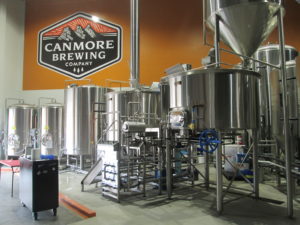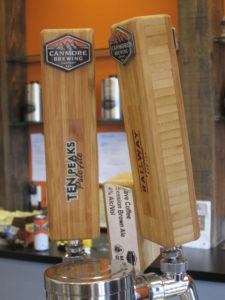 Our interview kept getting interrupted by people banging on the locked door, hoping for beer. Irritating? Not really. Instead I realized it was a sign of Canmore Brewing’s early success.
Our interview kept getting interrupted by people banging on the locked door, hoping for beer. Irritating? Not really. Instead I realized it was a sign of Canmore Brewing’s early success.
Currently the tap room is only open Thursday thru Sunday, meaning my visit on Tuesday was when they were officially closed. That didn’t seem to stop a regular stream of customers from trying to grab a pint or growler fill. Co-owner Brian Dunn tells me that it is a daily experience and enough to interfere with the work day. They are currently looking for additional staff to allow them to open the tap room throughout the week.
Canmore opened its doors in January and this week was my first opportunity to visit the brewery and try their beer (I did a profile before they opened, which you can read here). Dunn showed me around the well-appointed tap room and brewery, explained the odd arrangement the AGLC has forced them into with RAW Distillery, which shares the space (the AGLC balked at two licenses at the same location), and offered up some samples of their first beer.
I’ll get to the beer in a moment, but first I want to discuss the look and feel of Canmore Brewing. It is located in a fairly nondescript light industrial strip mall near the railway tracks on the outer edge of downtown. But when you walk in, the space seems relaxed and welcoming. They have worked hard to create a coherent branding. The space – and the logo – emphasize a stand-out orange with simple lines and feel. They are the first brewery in North America (yes, this is very inside baseball) to use painted cans with oriented labels (translation: they have pre-printed cans but add a specific label to the lower half for each beer which needs to be aligned with the painted logo). The effect is to create both a consistent look but still create differentiation between beer.
The more time I contemplated their look, the more I realized it had a noted uniqueness to it. The look is simple but unlike any other brewery I can think of. Orange might be a controversial colour in Alberta these days, but I think the effect works.
 The beer seems to represent where they are located. Canmore is a mix of the moneyed , outdoors fanatics and tourists; satisfying them all is not easy. Canmore is going with four core beer and a rotating seasonal. Appropriately each is named for regional landmarks. Ten Peaks Pale Ale (named after the iconic peaks shown sometimes on Canadian 20s) is a gentle, malt accented pale ale that Dunn acknowledges is their gateway beer they offer to people who call themselves corporate lager drinkers. Georgetown Brown (which is a ghost town near Banff) is a rounded brown ale on the sweeter side. Mineside Stout (the old name of the south end of Canmore) is an earthy, full-bodied stout. Railway Avenue IPA has enough hops to be a legitimate IPA but remains quite accessible and balanced. Their current seasonal is Rave Coffee Session Brown Ale, which is a toned down version of their Georgetown with cold-pressed coffee from Rave Coffee infused. It might be the smoothest coffee ale I have tasted in a while. You get full coffee flavour without the harsh bitterness that often comes with the use of coffee. Nicely done.
The beer seems to represent where they are located. Canmore is a mix of the moneyed , outdoors fanatics and tourists; satisfying them all is not easy. Canmore is going with four core beer and a rotating seasonal. Appropriately each is named for regional landmarks. Ten Peaks Pale Ale (named after the iconic peaks shown sometimes on Canadian 20s) is a gentle, malt accented pale ale that Dunn acknowledges is their gateway beer they offer to people who call themselves corporate lager drinkers. Georgetown Brown (which is a ghost town near Banff) is a rounded brown ale on the sweeter side. Mineside Stout (the old name of the south end of Canmore) is an earthy, full-bodied stout. Railway Avenue IPA has enough hops to be a legitimate IPA but remains quite accessible and balanced. Their current seasonal is Rave Coffee Session Brown Ale, which is a toned down version of their Georgetown with cold-pressed coffee from Rave Coffee infused. It might be the smoothest coffee ale I have tasted in a while. You get full coffee flavour without the harsh bitterness that often comes with the use of coffee. Nicely done.
I find the beer to be well-made, clean and flavourful. None are classics of their style, but every single one has an interesting, enjoyable character that I think will appeal both to beer aficionados and casual beer tourists as well.
These are early days for Canmore Brewing. They are, like many of the young Alberta breweries, struggling to keep up with demand and trying to figure out how to grow without stretching too far too fast. Plus, I note, they have not yet experienced a busy Canmore summer tourist season. Good luck with that, Brian and company. Given the numbers banging on your doors already, I think you should get ready for an onslaught in July.
[Edited to correct tap room opening days]


Leave a Reply